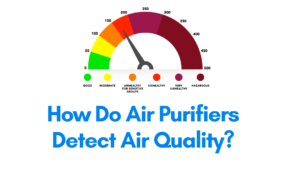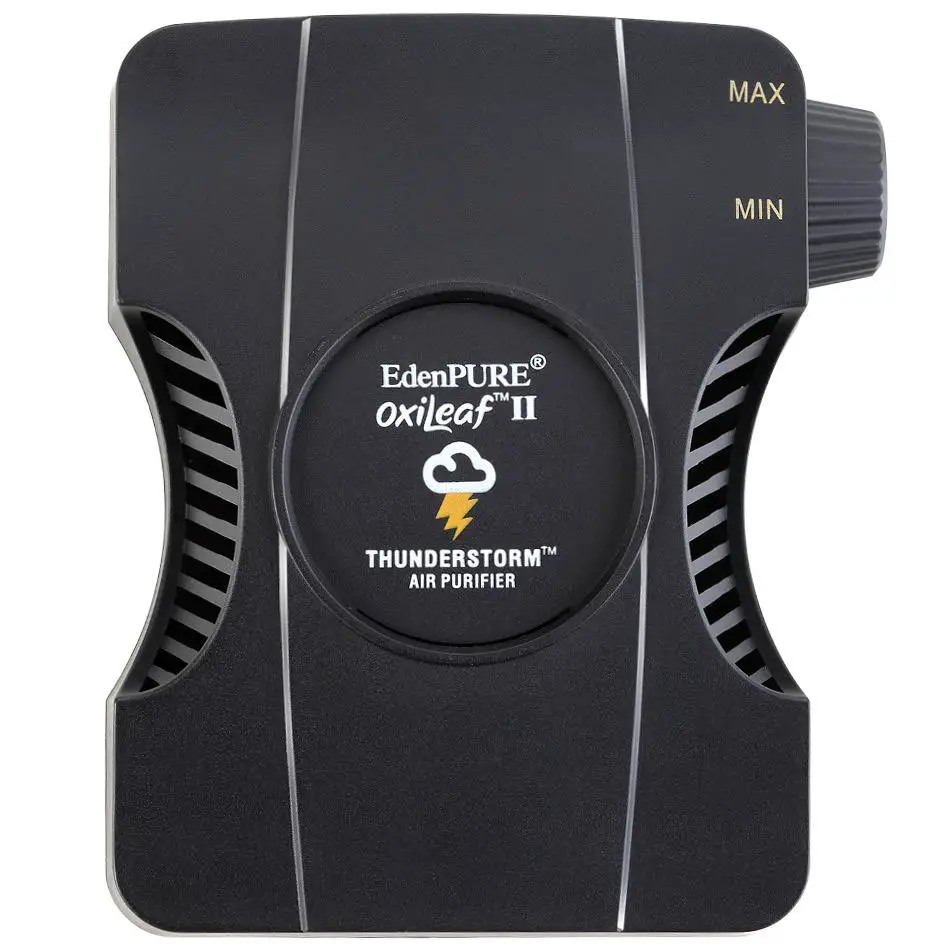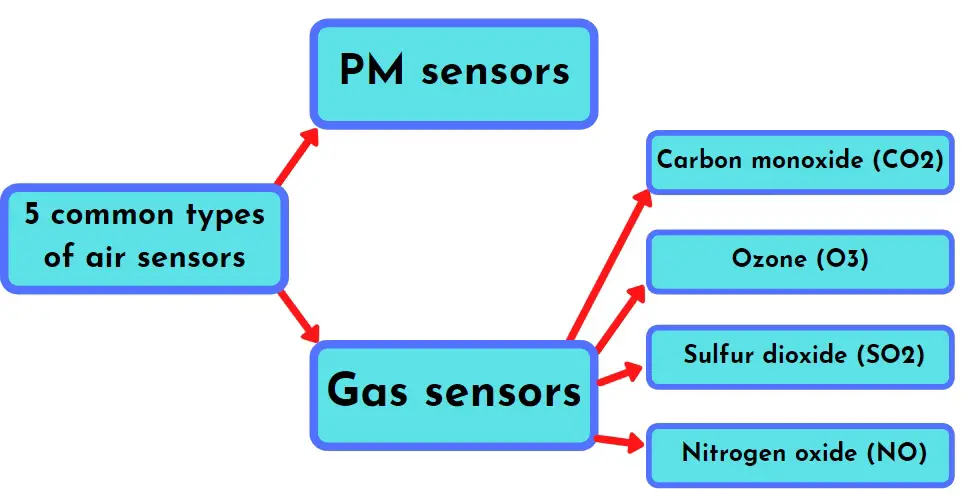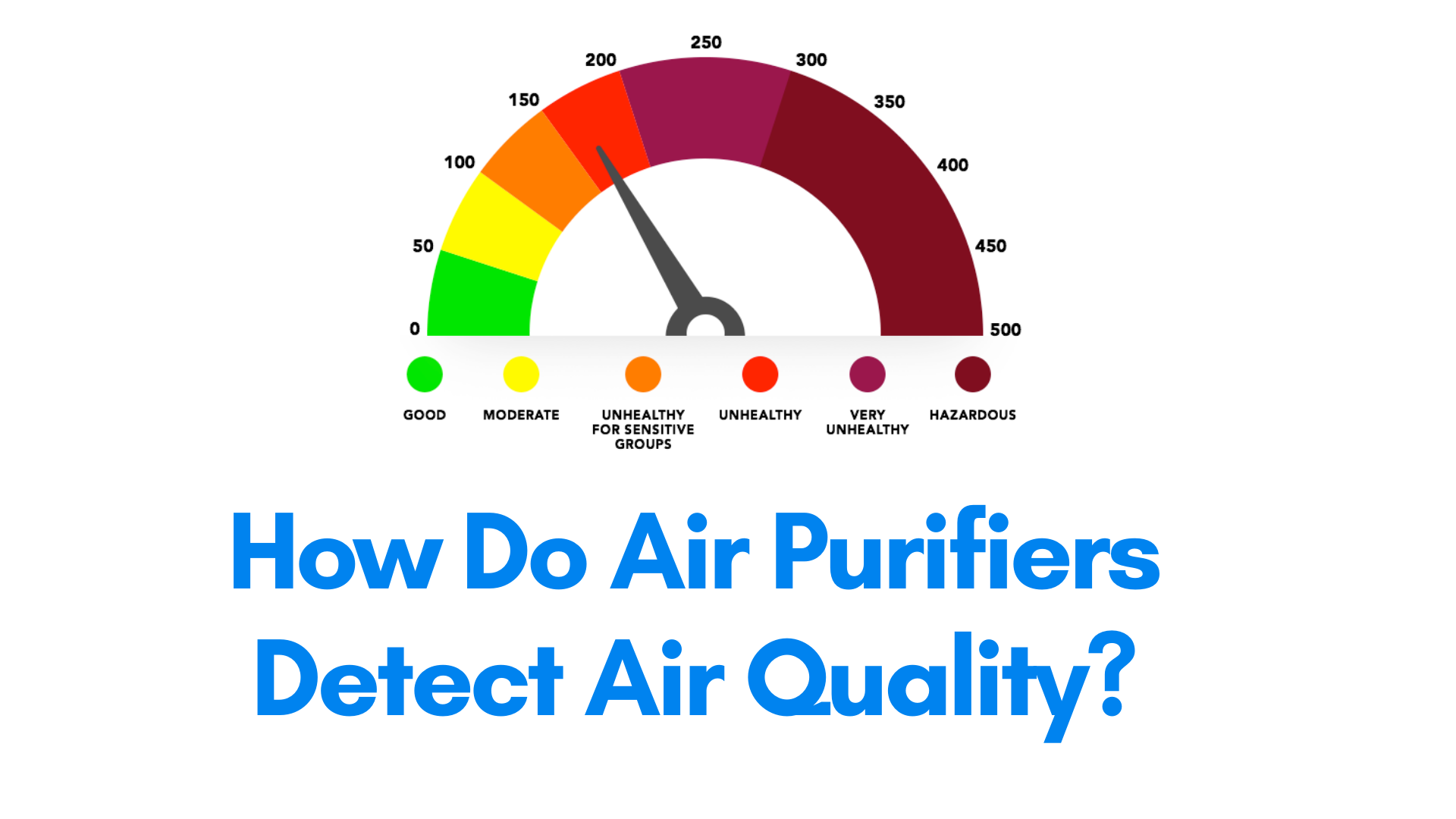If you are the owner of an air purifier or plan to get one, you will notice that quite a few of them can detect air quality in real-time. This air quality detection feature can be found in many middle & high-end air purifiers, sometimes even in cheaper ones.
How do air purifiers detect air quality?

In short, air purifiers can detect air quality through built-in air purifier sensors that measure the number of harmful particles in the air. These sensors usually operate together with an infrared or laser beam. Particles that move through the beam and sensor absorb a small amount of light – this change is then registered by the sensor, giving you an air quality evaluation.

Edenpure Oxileaf II Thunderstorm
Edenpure Oxileaf II Thunderstorm air purifier is just the perfect choice for indoor pollution
Most air purifiers have a PM sensor that measures particulate matter, but some air purifiers also come with a gas sensor. High-end air purifiers usually have more advanced sensors that give more accurate air quality readings. The readings are then displayed on a screen or through led indicators, usually on a color scale. In most cases, red color indicates terrible air quality, and blue indicates good air quality. Air purifiers with air quality sensors may be a bit expensive, but they are worth it.
Not all air purifiers come with a built-in air quality sensor tho. So try to buy anair purifier with sensor. But the ones that do can have more than one sensor, although this is primarily a feature of expensive air purifiers. Let’s dive a little deeper!
Different types of air quality sensors that Detect Air quality
To fully understand how air purifiers detect air quality, we must know which different types of air quality sensors exist and which ones we can find in air purifiers. In general, we have five common types of air quality sensors, which we can divide into two main groups: PM (particulate matter) sensors and gas sensors. Gas sensors consist of ozone, carbon monoxide, sulfur dioxide, and nitrogen oxide sensors separately.

PM sensors
PM sensors normally measure the concentration of PM2.5 particles in the air. PM2.5 simply means particles that have a diameter of up to 2.5 microns. You can think of microns as a measuring scale for really (and I mean really) small things. To give you a general idea – one inch (2.54 cm) is the equivalent of 25.400 microns! PM2.5 are also among one of the most dangerous particles and is a big part of the huge indoor air pollution, along with PM10 particles (these have a diameter of up to 10 microns). Here are some of the common harmful particles in the air you breathe and which PM group they belong to:
- dust (<PM10)
- pollen (<PM10)
- mold (<PM10)
- combustion particles (<PM2.5)
- organic compounds (<PM2.5)
- metals (<PM2.5)
To recap: PM10 means particles that are 10 microns and below. PM2.5 refers to particles that are 2.5 microns and below. That means that PM10 also includes PM2.5 particles.
The technology behind PM sensors can also vary. This is a very technical topic, but I will try to give you the most watered-down summary for an easier understanding. Most air purifier sensors use infrared technology to measure PM2.5 and laser technology to measure PM10 particle concentration. Laser sensors (sometimes referenced as laser dust sensors) can detect particles above 0.1 microns in size, while infrared PM2.5 sensors can only detect particles sized above 0.5 microns. In other words, laser sensors give more accurate readings than infrared sensors.
Gas sensors
Gas sensors measure the concentration of various gaseous air pollutants. Usually you will find separate sensors for separate dangerous gases. These are the gases that are commonly measured:
- Ozone (O3)
- Nitrogen Dioxide (NO2)
- Sulphur Dioxide (SO2)
- Carbon Monoxide (CO)
- Hydrogen Sulphide (H2S)
- Methane (CH4)
- Benzene (C6H6)
Air purifiers are a little special in this area as they do not use separate gas sensors. Instead, they use a “combined sensor” that can detect many different gasses, including VOCs (volatile organic compounds). Most air purifier product descriptions will call this simply “VOC sensor”.
We currently have three cheap ways of measuring the concentration of gases in the air: metal-oxide-semiconductor (MOS) sensors, electrochemical (EC) sensors, and micro-electro-mechanical systems (MEMS). MOS and MEMS are both commonly used technologies in air purifiers, as they are very accurate regarding VOC sensitivity and detection.
Which air quality sensors do air purifiers use?
Pretty much all air purifiers that I have seen so far (that had an air quality monitor) had a PM sensor – more specifically, a PM2.5 or PM10 sensor type. These sensors are sometimes called “particle sensors” or “dust sensors,” but do not let that confuse you in a product description. If the product description only mentions a “dust sensor,” you can almost be sure it is a PM10 one (refer to the list of harmful air particles one paragraph above).
I saw only a few advanced and more expensive air purifiers that came with a gas/VOC sensor and a standard PM sensor. Some air purifiers also come with both PM2.5 and PM10 sensors.
As for the technology used in these…you will have to check the individual product descriptions for that – sometimes they have it listed, sometimes they don’t. You can always turn to the manufacturer if you can not find the information you need. But higher-priced air purifiers will usually use better technology in their air sensors, giving you the most accurate results.
Effectiveness of air quality sensors in air purifiers
One of the big questions is how effective air purifier air quality sensors. Well, it depends on the technology used in these sensors, the type of sensors they use, and the display method.
Many middle and high-tier air purifiers come with a built-in air quality sensor. The most common one you will see is a PM2.5 sensor – these are the ones that measure particles up to 2.5 microns, are usually the cheapest to make, and provide the most fundamental results/readings. Next are PM10 sensors (called dust sensors), which give you a better air quality picture, as they include PM2.5 particles and all other harmful air particles up to 10 microns in size. The least frequent air quality sensor type you will find in an air purifier is a VOC sensor – these are mostly reserved for high-end air purifiers.
Infrared PM2.5 sensors are the most widely used sensor type in air purifiers. While they do their job, they don’t give you very accurate measurements. I always prefer air purifiers that use laser beam technology because they give more accurate air quality readings. As for the VOC sensors – the ones I came across were good and accurate, so they appear to be effective.
I also want to quickly talk about the display method (by this, I mean how the air quality is displayed) – most air purifiers use a color scale to gauge and show you the current air quality. While this is a very straightforward approach (it also looks cool), it does not give you much information. So you cannot know the number of harmful air particles and how they change over time. If your air purifier features a screen that shows you an air quality index (or just any number), then you have an above-average air sensor in terms of effectiveness.
What about standalone air sensors?
I want to touch on the topic of standalone air sensors quickly. These are devices that are explicitly used to measure air quality. Most of them come with many different sensors and measuring PM2.5, PM10, and VOCs (or gasses) is pretty standard.
In terms of effectiveness, a standard standalone air sensor will be more powerful and accurate than a standard built-in air sensor of an air purifier. This is because a standalone air sensor usually costs around the same as an entry-level air purifier. Consequently, they are built using more advanced technologies and give you more accurate results.
While you do not need a standalone air sensor, they are a great tool to confirm how effectively an air purifier is removing air pollutants. This is because an air purifier’s sensor will only analyze the air directly around it. On the other hand, you can put a standalone air sensor in the opposite side of the room where your air purifier is located. That way, you can check if the air purifier can effectively cover the whole room and make adjustments if it doesn’t.
Are air quality sensors worth having in an air purifier?
Yes, I think air purifiers that use air sensors are very much worth it. While I mentioned a few downsides, air sensors are a great feature. This is especially true if they use proper technology and better sensor types.
The first significant benefit is that an air quality sensor enables automatic mode. This feature allows the air purifier to change its settings (such as fan speed) according to the current air quality. By doing so, you get the most out of your air purifier in terms of optimal power consumption. So, an air quality sensor is a very cost-effective feature.
They also give you a visual confirmation of the change in air quality in your room. Despite its shortcomings, even a simple color scale display is a great way to get a general idea of how polluted your air is. Since these sensors work in real-time, you also see visual improvement.
Lastly, air quality sensors tell you which general trend you are moving regarding clean air. If your air quality keeps worsening or is not improving, you can more easily point out and test possible culprits. You change one factor and see if it affects the air quality sensor readings.
To sum it up, air quality sensors are a great feature in any air purifier. Even the lower quality ones have their benefits and uses. If you can, get the better ones that measure PM10 or VOCs, as they generally use better technology.
Recently I put together a list of the top 5 best air purifiers with air quality sensors, which you might find relevant. Feel free to check it out by clicking here.
Do air purifiers measure air quality?
Yes, Air purifiers measure air quality. Air Purifiers measure Air quality by using the air quality sensors.
How to test air purifier sensor?
To test an air purifier sensor, use an aerosol spray or cigarette smoke near the purifier’s intake, and observe if the sensor detects and adjusts the air quality readings.
